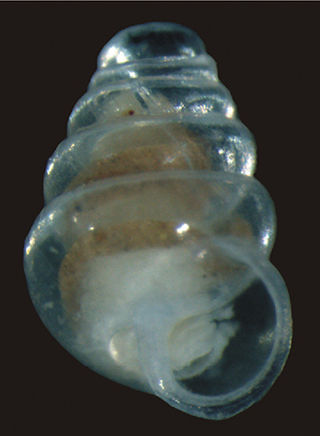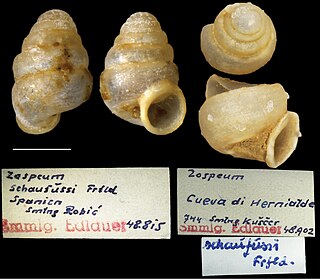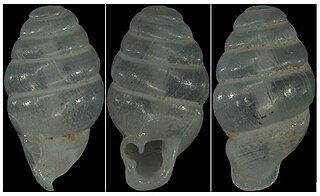
The Paklenica karst river canyon is a national park in Croatia. It is near Starigrad, northern Dalmatia, on the southern slopes of Velebit mountain, not far from Zadar. It contains two canyons, Mala (Small) and Velika (Big) Paklenica.

The Velebit mountains of Croatia have several deep caves with some of the world's largest subterranean vertical drops.

Velebit is the largest, though not the highest, mountain range in Croatia. The range forms a part of the Dinaric Alps and is located along the Adriatic coast, separating it from Lika in the interior. Velebit begins in the northwest near Senj with the Vratnik mountain pass and ends 145 km to the southeast near the source of the Zrmanja river northwest of Knin.

Schizoglossa novoseelandica is a predatory species of air-breathing land slug or semi-slug, a terrestrial gastropod mollusc in the family Rhytididae. It is the type species of the genus Schizoglossa and is found only in New Zealand. The survival of this species is not threatened; it is not listed in the 2009 IUCN Red List nor is it in the 2005 New Zealand Threat Classification System lists.
Vertigo dedecora is a species of very small air-breathing land snail, a terrestrial pulmonate gastropod mollusk or micromollusk in the family Vertiginidae.

Zospeum is a genus of air-breathing land snails, terrestrial pulmonate gastropod mollusks in the family Ellobiidae, the salt marsh snails.

Carychium tridentatum is a species of minute air-breathing land snail, a terrestrial pulmonate gastropod mollusk in the family Ellobiidae.

Vertigo milium, common name the blade vertigo, is a species of minute air-breathing land snail, a terrestrial pulmonate gastropod mollusk in the family Vertiginidae, the whorl snails.

Cystiscus vavauensis is a species of very small sea snail, a marine gastropod mollusk or micromollusk in the family Cystiscidae.
Olivella perplexa is a species of small sea snail, marine gastropod mollusk in the subfamily Olivellinae, in the family Olividae, the olives. Species in the genus Olivella are commonly called dwarf olives.

Clanculus pharaonius, common name the strawberry topshell, is a species of sea snail, a marine gastropod mollusk in the family Trochidae, the top snails.

Gibbula multicolor, common name the multicoloured topshell, is a species of sea snail, a marine gastropod mollusk in the family Trochidae, the top snails.

Inchoatia inchoata is a species of air-breathing land snail, a terrestrial pulmonate gastropod mollusc in the family Clausiliidae, the door snails.

Zospeum tholussum or the domed land snail, is a cave-dwelling species of air-breathing land snails in the family Ellobiidae. It is a very small species, with a shell height of less than 2 mm (0.08 in) and a shell width of around 1 mm (0.04 in). Z. tholussum individuals are completely blind and possess translucent shells with five to six whorls. The second whorl of their shells has a characteristic dome-like shape. They are also extremely slow-moving and may depend on passive transportation through running water or larger animals for dispersal.

Zospeum percostulatum is a species of air-breathing land snail, a terrestrial pulmonate gastropod mollusk in the family Ellobiidae, the salt marsh snails. This species is endemic to Asturias, Spain. It is known from several limestone caves near Llanes. Though there were a few old records of Zospeum in Asturias, dubiously identified as Z. suarezi and Z. schaufussi, Zospeum percostulatum is the first species described for this autonomous community.

Zospeum vasconicum is a cave-dwelling species of air-breathing land snails.
Zospeum zaldivarae is a cave-dwelling species of air-breathing land snail.
Zospeum robustum is a cave-dwelling species of air-breathing land snails.
Zospeum bucculentum is a cave-dwelling species of air-breathing land snails.

Laoennea renouardi is one of two species in the genus Laoennea of the Asian terrestrial snail family Diapheridae.















